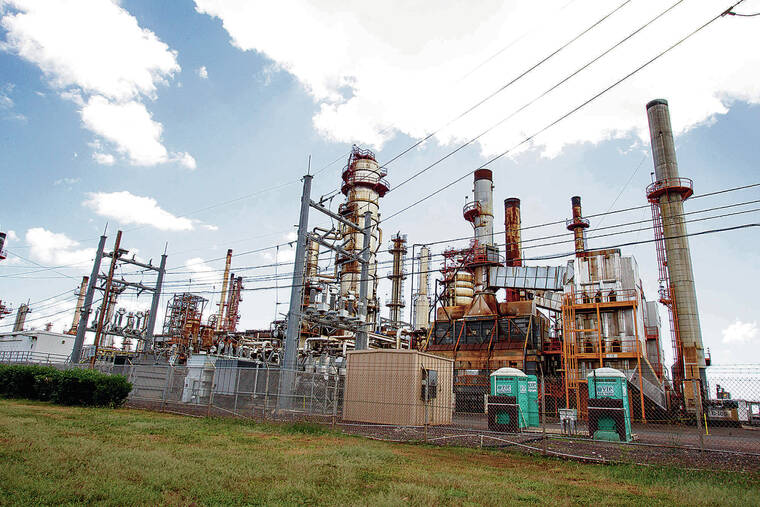
Mahalo for supporting Honolulu Star-Advertiser. Enjoy this free story!
As the Navy faces increasing pressure to drain the tanks at its Red Hill fuel storage facility, the question of where the fuel could be relocated is moving to the forefront.
As various proposals are taking shape, what’s clear is that, given the complexities tied to the massive underground site, there’s no quick-fix answer for permanent relocation.
Even so, the U.S. Senate last week passed a funding bill that includes a provision requiring the Department of Defense to abide by a state emergency order issued by the state Department of Health to drain the tanks and provides $100 million in funding for the process. President Joe Biden signed the bill into law Friday.
Further raising the ante, on Feb. 11, Hawaii’s congressional delegation introduced legislation that would require the Navy to cease fueling operations at Red Hill, drain all the tanks by the end of the year and permanently decommission the facility.
In November, jet fuel from the facility tainted the Navy’s water system that serves 93,000 people on Oahu. While decontamination efforts continue, the Department of Defense is fighting the state’s emergency order to defuel the tanks, which sit above a critical aquifer that provides drinking water for a large swath of southern Oahu.
Built underground during World War II to make it difficult for enemy forces to strike, Red Hill’s 20 massive tanks are capable of holding up to 250 million gallons of fuel. Its unique location inside a mountain range makes it both subterranean while also at a high enough elevation that it can use gravity to funnel fuel into a series of pipelines to military installations where it’s used in aircraft, ships and other transport.
While the Navy has shut down aging underground facilities elsewhere, commanders consider Red Hill one of their most secure remaining locations for strategic fuel reserves and so far have signaled resistance to relocation, citing the facility’s role in supporting operations in the event of a major conflict in the Pacific.
Navy commanders have argued that moving the fuel to a new facility would be an incredibly costly, time- consuming use of resources. A 2018 analysis commissioned by the Navy found that building a new facility to replace Red Hill could cost $4 billion to $10 billion and take until 2051 to complete.
On the other hand, in recent months contamination of the Navy’s water system here has also tied up military resources, pulling personnel from each branch from normal duties to assist with remediation efforts, delivering truckloads of clean water to afflicted families and other tasks. And the costs are quickly piling up.
What’s more, the engineering feat that made Red Hill nearly impossible for WWII enemy forces to find and strike has also made the facility difficult to maintain. Over eight decades those challenges have increased. The ongoing tainted-water crisis apparently stemmed from a fuel spill in May that made its way into the fire suppression system, which eventually burst in November and spilled into the Red Hill water well.
Red Hill’s maintenance challenges bolster the argument that the military badly needs to shift toward a “more resilient fuel infrastructure as opposed to the currently very brittle one that’s been optimized over time by DOD to save costs,” said Timothy Walton, a defense and technology researcher at The Hudson Institute in Washington, D.C.
Additionally, Walton said, Red Hill is among storage setups that are “misaligned with the current threat environment” as China rapidly upgrades its own military.
After a meeting with Gov. David Ige in January, Deputy Secretary of Defense Kathleen Hicks said the military hasn’t ruled out permanently draining the facility. Rather, the Pentagon intended to fight the emergency order to “afford us time to make evidence-based and transparent decisions.”
Responding to that stance, state Rep. Bob McDermott, (R, Ewa Beach), said, “They don’t understand the local mindset of purity — water is life, aloha aina, all that. They don’t get it.”
The water crisis, and the Navy’s handling of it, has soured relations between the military and surrounding communities as well as relations between military families and top Navy officials. Military medical teams have examined thousands of people complaining of symptoms including nausea, headaches and rashes. And the military has moved thousands of military families into hotels while the cleanup is underway.
McDermott has drawn up a proposal for relocating Red Hill fuel, which he has presented at some neighborhood board meetings. His plan calls for distributing most of the fuel to military fuel depots that already exist around the Pacific and keeping about 75 million gallons at Par Hawaii’s oil products refinery facilities at Campbell Industrial Park.
Other state officials, including Lt. Gov. Josh Green, have been looking to Par Hawaii’s facilities as a potential place to store at least some of Red Hill’s fuel, possibly for the long term.
A Marine Corps veteran and former Honolulu Navy League executive director, McDermott last month announced his intention to run against Democratic incumbent U.S. Sen. Brian Schatz. Citing national security reasons, Schatz has declined to comment on alternative sites for Red Hill fuel.
McDermott said his plan would make fuel more accessible during a potential conflict in the region, including at existing facilities in Japan and South Korea. Though McDermott has taken a hard line on closing the facility and criticized Navy commanders, he said he considers national security a top priority.
But moving fuel farther into the Pacific is the opposite of the direction the Pentagon has been going in recent years. Military planners have worried that fuel stores around Asia, particularly in Japan and South Korea, could be cut off if enemy forces were to set up naval blockades and cut the fuel supply lines tethered to the U.S. and its allies.
Walton pointed out, “There’s been a recognition that DOD has lots of fuel in locations that might be inaccessible, or heavily contested, in a conflict.” He added that has prompted a plan in the works to relocate some fuel reserves to Australia from Northeast Asia and that places “greater emphasis on fueling in Hawaii.”
In January the U.S. military began building a $270 million facility in Australia’s Northern Territory where the U.S. Marine Corps maintains a force of about 2,500 Marines that is expected to grow larger. It will have 11 large above-ground tanks capable of holding nearly 80 million gallons of jet fuel.
The Pentagon has been shutting down underground fuel storage tanks in California, Washington state and the Republic of the Marshall Islands and shifting to above-ground tanks. Walton said the shift is a cost-saving measure as above-ground tanks are considerably cheaper to build and easier to operate.
“Above-ground storage tanks also have the benefit that they’re easier to maintain and pose … fewer environmental risks. The spills will usually be more easily cleaned up,” said Walton.
However, he said, “They are considerably more vulnerable to attack, and that’s problematic — and it’s made it so that a larger proportion of DOD underground bulk fuel stores are now consolidated in Red Hill.”
Commanders worry that key facilities could be targets for missiles or bombers, and are particularly protective of fuel reserves. Walton said that the rugged terrain that encases Red Hill would protect the tanks even from most “bunker-
buster” munitions.
But he noted that various openings into the facility could be vulnerable and that there’s a potential threat of saboteurs attacking or even intentionally spilling the fuel into the aquifer during a war.
To correct the apparent problem of having too many eggs in too few baskets, Walton said, “We need to distribute our fuel stores to more locations; have a more resilient architecture that can adapt to enemy attacks; and also make it so that no attack will be extremely consequential, either on the military operations or also on our civilian population in terms of causing an environmental catastrophe.”
In 2018 the Navy released a review of alternative sites for the Red Hill fuel farm on Oahu that designated most proposed options as unsatisfactory as long-term solutions because their lower elevations would not allow for gravity-fed pipes.
The review’s appraisal of Par Hawaii’s facilities found that “it matches the surrounding land use perfectly. Otherwise, it does not have many attributes that make it a reasonable choice. For instance, the low elevation of the site would require significant fill material to build the site and necessitate an engine-driven pumping system.”
The Navy also asserted moving fuel from storage at Par Hawaii to Joint Base Pearl Harbor-Hickam’s fueling piers would require building a 15-mile fortified pipeline tunnel, which could pose more risk of delays, cost overruns and potential pollution.
Walton said that the military could use a mix of above-ground tanks and much smaller underground tanks — placed carefully, taking into account strategic, environmental and public health concerns. He also advocated looking to oil tankers.
Congress in 2020 authorized creation of the Tanker Security Program, which provides stipends for a fleet of 10 U.S.-flagged tanker vessels crewed by civilian mariners in exchange for a commitment that the vessels would be available to the military during a conflict or national emergency. The program has yet to be funded.
“Either those tankers or, preferably, additional tankers that would be leased by the Maritime Administration (and) provided to the Military Sealift Command, could provide some of those floating fuel stores,” said Walton.
“An important element of a more resilient architecture will be, I think, more tankers in general, so that we can distribute fuel throughout the theater more effectively and it’s not just stuck in … Red Hill on Hawaii, or in Guam.”
U.S. Rep Kai Kahele, D-
Hawaii, an Air Force veteran, has taken military leaders to task during congressional hearings on Red Hill matters. During one held in January, he said Hawaii had reached an “inflection point” in its “relationship with the United States military moving forward.”
But while he has forcefully called for Red Hill’s permanent closure, Kahele has also pushed for increasing military resources in the Pacific to check China.
In November he led several lawmakers in sending a letter to the Pentagon calling for a significant increase in Air Force funding and more warplanes. At that time he told the Honolulu Star-
Advertiser, “We need as many of those F-35s as we can get off the production line.”
During a news conference Kahele held Feb. 11 with U.S. Rep. Ed Case, D-Hawaii, Kahele said the military is currently relying on above- ground tanks in Hawaii and could move fuel from Red Hill into them as they become depleted — as well as move fuel to Par Hawaii’s facilities or load it onto oil tankers at sea.
“The Navy will need to look at how to distribute that fuel across the INDOPACOM region,” said Kahele. “The people of Oahu should not bear the burden of the nation’s strategic fuel reserve sitting 100 feet above one of the most critical aquifers on this island.”
Source: Star Ads





